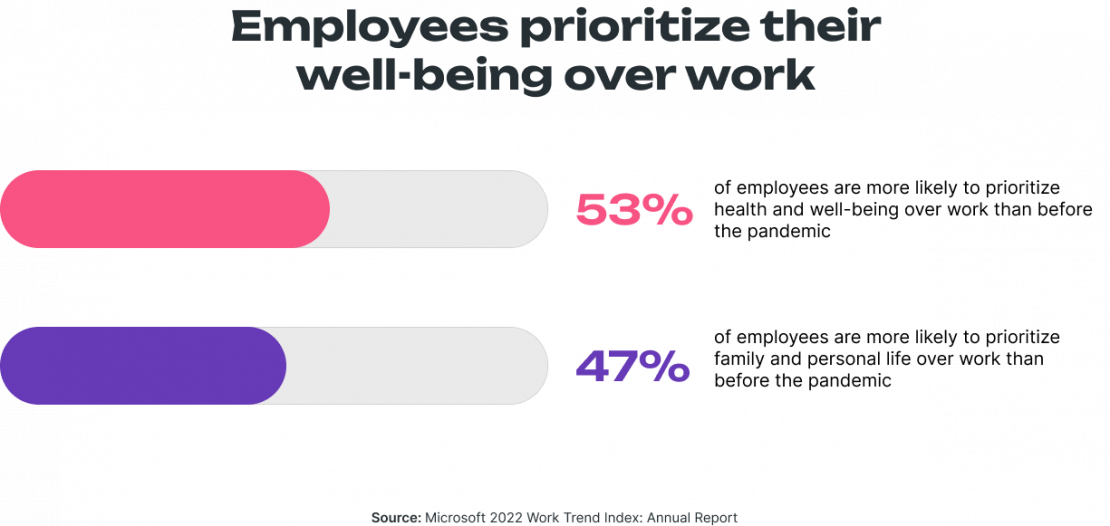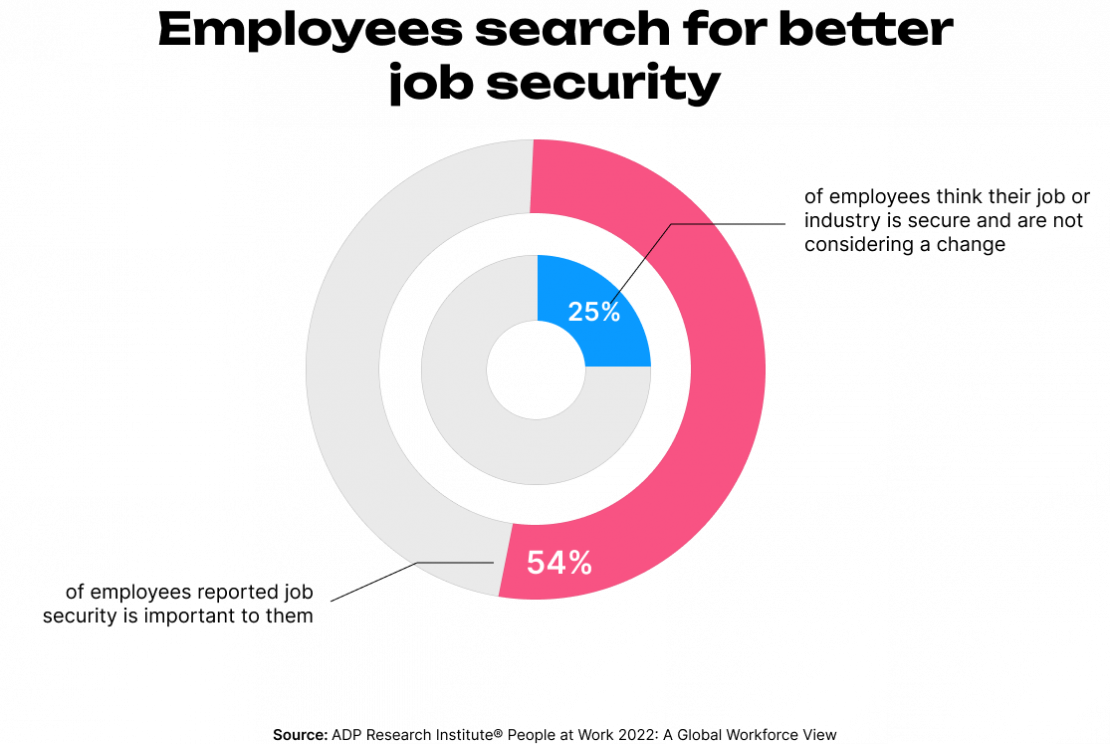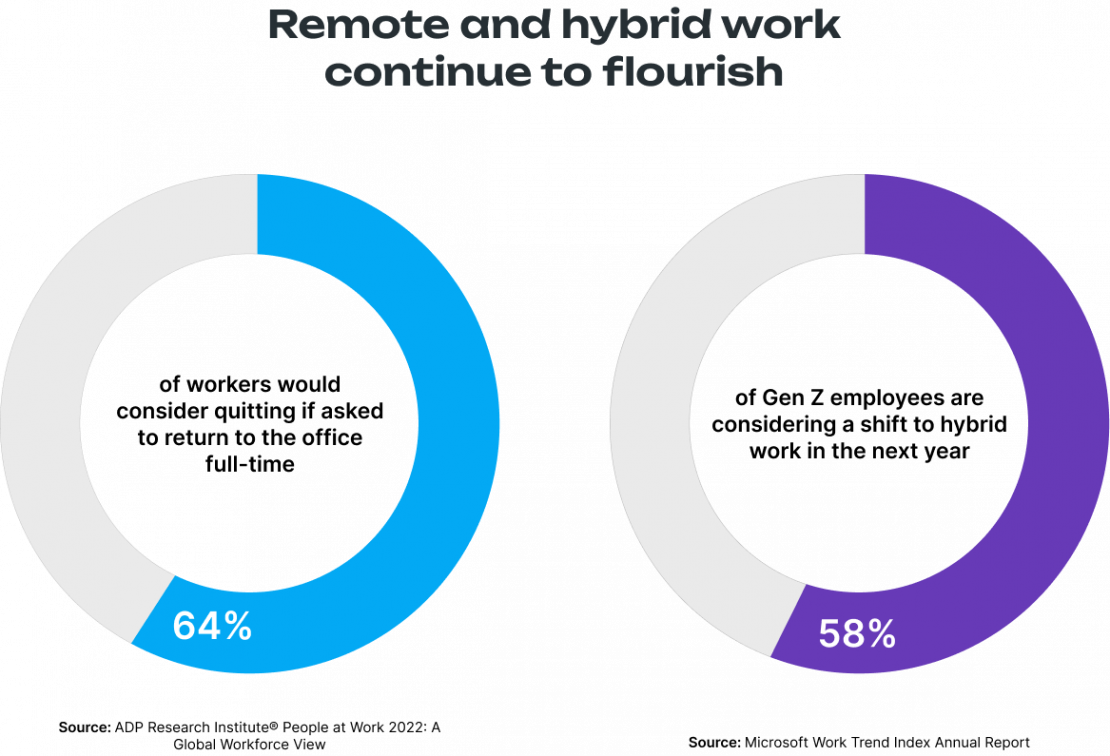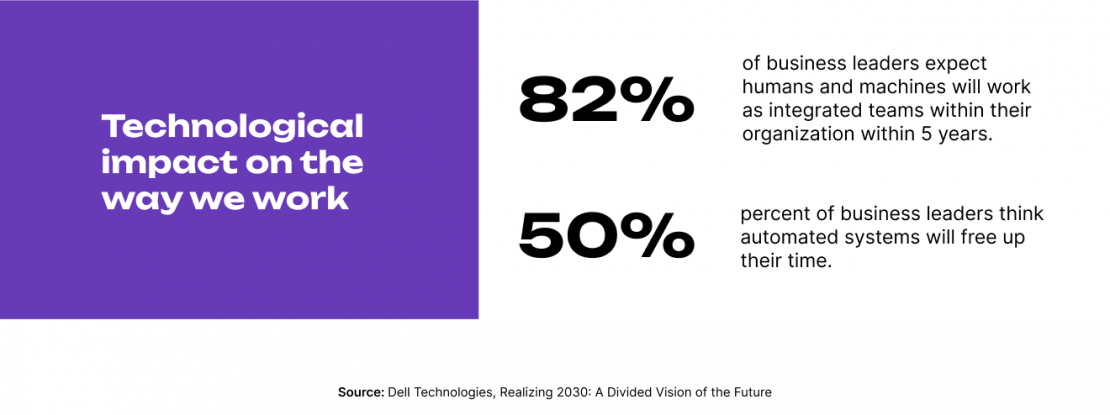Over the last few years, the concept of work has changed tremendously.
For many professionals, remote or hybrid work has replaced work-from-office.
The COVID-19 pandemic has accelerated changes and shown us that different work models can function equally well, if not better, than the previously glorified work-from-office standard.
As time passes, it is evident that these changes are here to stay.
However, there are some open questions:
- What does the modern workforce want?
- What should companies do to meet their needs?
- What will the future of the workforce, workplace, and work be?
We did the research and compiled facts and figures about:
- Future of workforce trends,
- Future of work trends, and
- Future of workplace trends.
Here’s what we have discovered.
Future of workforce trends
It’s quite simple — the work isn’t going to do itself. We need people to get it done.
But, what does the workforce want?
Here are some workforce-related trends that will likely continue in the future:
- Employee turnover continues to increase.
- The mobility of talent will likely increase.
- Employees prioritize their well-being over work.
- Employees search for better job security.
Trend #1: Employee turnover continues to increase
Remote and hybrid work is no longer considered a benefit — it has become the norm for many knowledge workers.
Many of us worked partially remotely before the pandemic. Still, the vast majority of now fully remote or hybrid workers transferred to these work models when the COVID-19 pandemic hit.
As reported in the Harvard Business Review’s “11 Trends that Will Shape Work in 2022 and Beyond” article, “In the U.S., employees expect flexibility within their job as much as they expect a 401(k).”
Employees want flexibility when it comes to their workplace. When they don’t have it — they tend to leave for a place offering what they need.
According to Gartner, US employee annual voluntary turnover is likely to jump nearly 20% from a pre-pandemic yearly average.
A pre-pandemic annual average of employees quitting their jobs was 31.9 million. Gartner predicts this number is likely to jump to 37.4 in 2022.
That is almost 6 million more employees quitting, compared to 2021.
One question arises — how can you attract and retain talent?
Gartner suggests organizations abandon office-centric work design and shift to a human-centric work design.
What does that mean?
A human-centric work design means employers must redesign their Employee Value Proposition (EVP) to deliver employees a more human deal, meaning more focus on their feelings and the features they need.
Trend #2: The mobility of talent will likely increase
Many companies have changed their policies regarding hiring the workforce and preferred work models.
The remote work option has opened more opportunities for people to work for companies that did not consider hiring employees from outside of their cities or countries before.
However, remote work is only one of the factors influencing the increasing mobility of talent. Global talent shortage also plays a huge role.
The World Economic Forum addresses the mobility of talent as one of the key trends influencing the future of work in their “Five key trends shaping the new world of work” article. The global war for skilled talent has led to more opportunities for workers to move across jobs, industries, and countries.
ManpowerGroup’s Global talent shortage report for 2022 reveals that global talent shortages have reached a 16-year-high as 3 in 4 employers report difficulty finding the talent they need.
The survey of over 40,000 employers across 40 countries and territories revealed that talent shortage is high across all industries:
| Percentage | Industry |
|---|---|
| 76% | Education, health, and government |
| 76% | IT & technology |
| 76% | Manufacturing |
| 75% | Banking & finance |
| 75% | Wholesale & retail trade |
| 74% | Restaurants & hotels |
| 72% | Construction |
Companies want to attract and retain top talent. More flexible work models allow employees to find more job opportunities without the need to move.
Not so long ago, the term employee mobility was reserved for physical mobility. Nowadays, employee mobility includes the virtual mobility of an employee as well.
According to the World Economic Forum, the future looks likely to hold higher trade tariffs and tighter border control, but we have yet to see what this means for workers’ physical mobility.
On the other hand, virtual mobility has no such limits.
Trend #3: Employees prioritize their well-being over work
Microsoft 2022 Work Trend Index: Annual Report reveals that employees value their well-being more than ever. Precisely, 53% of employees are more likely to prioritize health and well-being over work than before the pandemic.
The numbers are higher for parents and women — 55% of parents and 56% of women declared they are more likely to prioritize their health and well-being over work.
Priorities have shifted.
According to the same study, 47% of respondents are more likely to prioritize family and personal life over work than they were before the pandemic.

Other studies have similar findings.
Gallup asked 13,085 US employees about the most important factor for them when deciding whether to accept a new job offered by a new employer. The study results revealed that a whopping 61% of employees consider greater work-life balance and better personal well-being as very important.
What people value most has changed. Employees now prioritize their well-being over work, which will likely continue in the future.
Trend #4: Employees search for better job security
In times of uncertainty, employees are looking for security.
The last two years were tough, and many people lost their jobs. The World Economic Forum reports that the COVID-19 pandemic and the lockdown caused 114 million people to lose their jobs in 2020.
Regarding things employees want in their next job, greater stability and job security are important for 53% of respondents, according to the previously mentioned Gallup study. They are looking for jobs that provide better stability and security than what they currently have.
Other studies report similar findings. According to the ADP Research Institute® People at Work 2022: A Global Workforce View study, more than half of workers (54%) reported job security is important to them.
However, only 25% of respondents think their job or industry is secure and are not considering a change.

Employees seek stability, and employers must show up as a stabilizing force they can count on in uncertain and turbulent times.
Future of workplace trends
Workplace standards have changed over the past few years. A shift to remote work, advances in technology, and a shift in employee expectations had a massive impact on workplace transformation.
Here’s what the future holds for us:
- Remote and hybrid work continue to flourish.
- Workplaces focus on accessibility.
- Companies strive to increase diversity, equity, and inclusion.
- Employers continue investing in employee well-being programs.
Trend #5: Remote and hybrid work continue to flourish
If you’re considering asking your employees to return to the office — think twice. Chances are high that you will lose your talent.
People at Work 2022: A Global Workforce View annual survey of over 32,000 workers across 17 countries revealed that 64% of workers would consider quitting if asked to return to the office full-time.

The same study has found that 74% of parents would like to arrange working hours to be more flexible, followed by 68% of non-parents.
According to the latest Microsoft Work Trend Index Annual Report, for younger employees, flexibility is non-negotiable. More than half (58%) of Gen Z employees are considering a shift to hybrid work in the next year.
The workforce is still in transition and wants to explore different work models.
Many hybrid employees are considering a switch to remote work (51%). On the other hand, even more remote employees are considering a switch to hybrid work in the year ahead — 57% of them.

Work-from-office is not a standard anymore, and companies must rethink their ways of working.
Trend #6: Workplaces focus on accessibility
According to the U.S. Chamber of Commerce, focus on accessibility will be the 2023 workplace trend.
Nowadays, we use various technological solutions to support work. However, some business operations still require and benefit from employees who show up in person.
As the U.S. Chamber of Commerce concludes, the focus in 2023 must be on connecting the right people to do the work that needs to be done. Additionally, business owners have to ask themself how their business can facilitate making work accessible to all, in a way that boosts productivity.
Forbes suggests a few ways companies can unlock business potential by Improving accessibility in the workplace:
- Creating workplaces with inclusive design,
- Using tech to meet individual needs,
- Promoting working where and how employees feel most comfortable, and
- Pinpointing opportunities for improvement, especially in the hiring process.
Trend #7: Companies strive to increase diversity, equity, and inclusion
Diversity, equity, and inclusion (DEI) policies will be even more important in years to come than they are now.
The Society for Human Resource Management (SHRM) predicts companies will continue striving to increase diversity, equity, and inclusion. According to SHRM, this will be one of the 6 major business trends until at least 2025.
Diversity, equity, and inclusion (DEI) policies have a significant role when workers consider a new job.
The previously mentioned ADP Research Institute® annual survey about people at work in 2022 has found that DEI policy has become a make-or-break issue for most workers.
Numbers don’t lie. A whopping 76% of employees would consider looking for a new job if they discovered an unfair gender pay gap or no DEI policy at their company.
Therefore, companies should focus on improving diversity, equity, and inclusion to make the world a better place and themselves attractive to the workforce.
Trend #8: Employers investing in employee well-being programs
Employee well-being has become the new workplace imperative.
Each year, Fortune research partner Great Place to Work compiles The World’s Best Workplaces list based on surveys of employees working for companies with offices worldwide.
As stated in Fortune’s article covering this year’s list of great places to work, the world’s best workplaces invest in well-being, flexibility, and equity.
However, the current state of workplace well-being does not look bright.
The latest Gallup State of the Global Workplace: 2022 Report reveals that most employees don’t find their job meaningful. Only 21% of employees globally are engaged at work, and just 33% are thriving in their overall well-being.
According to Entrepreneur, a big part of the millennial and Gen X population want more health and wellness-driven care that supports optimizing their health and is specific to their needs. They want to learn how to create better mental, physical, and spiritual health to prevent running to the doctor for sick care.
The article highlights the following needs:
- Mental health (counseling therapy),
- Bodywork (therapeutic massage),
- Alternative health care (including acupuncture, chiropractic, naturopathic),
- Coverage for supplements and IV or injection therapies, and
- Better health than their parents and grandparents.
Many companies expanded their wellness support when the pandemic hit in 2020.
A Harvard Business Review “11 Trends that Will Shape Work in 2022 and Beyond” article reveals that 94% of companies made significant investments in their well-being programs, and 85% increased support for mental health benefits.
Therefore, investment in employees’ well-being is one of the steps companies will continue to take in order to attract new and retain existing employees.
Future of work trends
What about work itself? How long will our workweek be, and which skills will we need? Here are the emerging trends for 2023 and the years to come:
- Workweeks are getting shorter.
- Digital skills are gaining importance.
- New technologies are emerging.
- There is a shift to skill-based hiring.
Trend #9: Workweeks are getting shorter
Employees want a shorter workweek, and there is no doubt about that.
A Qualtrics survey of over 1,000 US workers found that 92% of them would support their employer in implementing a 4-day workweek.
Here are some survey results:
| Percentage | Opinion |
|---|---|
| 88% | Said a 4-day workweek would improve their work-life balance |
| 79% | Said a 4-day workweek would improve their mental health |
| 82% | Said a 4-day workweek would make them more productive |
| 81% | Said a 4-day workweek would make them feel more loyal to their employer |
| 82% | Said a 4-day workweek would help their company recruit talent |
Working shorter weeks may actually improve productivity.
In 2019, Microsoft tested a 4-day week in a Japanese subsidiary. The result — productivity jumped by 40%.
In Europe, many companies have started experimenting and implementing a 4-day workweek — the experiments have been successful.
In June 2022, 70 UK companies and organizations signed up for the biggest ever 4-day week trial planned to run for 6 months, until January 2023.
According to Euronews, these companies are now planning on making it permanent, as they found the experiment ‘extremely successful.’
Increased productivity is not the only reason why some companies consider shorter workweeks.
As mentioned in the Harvard Business review article regarding trends that will shape work in 2022 and beyond, some companies will shorten the workweek rather than increase pay to compete in the war for knowledge worker talent.
Trend #10: Digital skills are gaining importance
Digital skills are gaining importance. An Urban Institute study regarding digital skills for career progress finds that “the number of jobs requiring digital skills is predicted to increase 12 percent by 2024.”
According to Forbes, the top 4 digital skills in demand are:
- Digital literacy,
- Data literacy,
- Technical skills, and
- Digital threat awareness.
However, Salesforce’s 2022 Global Digital Skills Index reveals a growing digital skills crisis.
Over 23,000 workers across 19 countries scored only 33 out of a possible 100 points on the Digital Skills Readiness Index.
The factors were the following:
| Readiness Index Factor | Score |
|---|---|
| Prepared with workplace digital skills needed now | 40% |
| Prepared with workplace digital skills needed in 5 years | 34% |
| Consider workplace digital skills important for work success | 65% |
| Skill level: everyday digital skills | 13% |
| Skill level: workplace digital skills | 17% |
| Equipped with resources to learn workplace digital skills now | 27% |
| Equipped with resources to learn workplace digital skills in 5 years | 24% |
| Active in acquiring everyday digital skills now | 34% |
| Active in acquiring everyday digital skills in 5 years | 30% |
| Active in acquiring workplace digital skills now | 28% |
| Active in acquiring workplace digital skills in 5 years | 26% |
In the United States, the situation is only slightly better, with a score of 36 out of 100 points.
Surprisingly, not even the digitally native Gen Z is comfortable with their digital skills level, with only 31% of respondents feeling “very equipped” for a digital-first job.
Therefore, companies should build training programs focused on top digital skills.
The US study respondents ranked these 5 workplace digital skills as most critical for businesses to invest in over the next 5 years:
- Collaboration technology,
- Digital administrative,
- Encryption and cyber security,
- Data science, DB mgmt, or analytical, and
- Project management technology.
Trend #11: New technologies are emerging
As Forbes reports, accelerated digital transformation will be one of the 5 biggest business trends In 2023.
We will see “the continuation of innovations and developments in transformative technologies such as artificial intelligence (AI), the internet of things (IoT), virtual and augmented reality (VR/AR), cloud computing, blockchain, and super-fast network protocols like 5G.”
Dell Technologies spent the past several years confirming this hypothesis.
They joined forces with Institute for the Future (IFTF) and 20 experts from around the world to project into the future and forecast how emerging technologies will affect work by 2030.
Here are some findings from Realizing 2030: A Divided Vision of the Future report:
- 82% of business leaders expect humans and machines will work as integrated teams within their organization within 5 years.
- 50% percent of business leaders think automated systems will free up their time.

Dell Technologies and IFTF also explored how emerging technologies could reshape the work environment over the next decade. According to their Future of Work report:
- 67% of business leaders expect to use new technologies to create equal opportunities by removing human bias in decision-making.
- 86% of business leaders plan to use emerging technologies to improve workforce productivity.
- 70% of business leaders would welcome people partnering with machines/robots to transcend our human limitations.
Another Dell Technologies report, The Next Era of Human and Machine Partnerships, reveals that 85% of jobs in 2030 have yet to be invented.
This is not surprising at all, seeing as new professions are already emerging as a result of technological advancement.
For instance, the invention of the Internet and search engines gave birth to some modern career paths, such as Search Engine Optimization (SEO). Similarly, in the 19th century, project management as we know it today didn’t exist. Modern project management dates from the 20th century, and nowadays, many professionals use project management software on a daily basis.
Undoubtedly, many more are yet to come.
Trend #12: There is a shift to skill-based hiring
Skills-based hiring is a new buzzword in HR, focusing on a candidate’s practical skills and performance instead of formal qualifications.
As Ryan Roslansky, CEO at LinkedIn, said, “skills are the new currency.” According to him, a skills-first labor market is emerging all around us.
He is not the only one thinking that.
The World Economic Forum also recognizes the shift to skill-based hiring as one of the key trends shaping the new world of work. According to their Five key trends shaping the new world of work article, many employers are eliminating degrees from their hiring criteria in favor of skills assessment.
Harvard Business Review (HBR) highlights that skills-based hiring Is on the rise. As HBR reports, employers are resetting degree requirements in a wide variety of roles. They are dropping the requirement for a bachelor’s degree in many middle-skill and even some higher-skill roles.
They provided Accenture and IBM as examples of companies who, by the end of 2021, “distinguished themselves in their efforts to walk back degree inflation.”
As HBR reports, 43% of postings for IT jobs at Accenture contained a degree requirement, and at IBM, only 29% did by the end of 2021.
According to HBR, a shift to skill-based hiring can be beneficial for both companies and workers.
“Previously overlooked workers will be able to pursue attractive career pathways even without a four-year degree, and companies will be better able to fill jobs that need filling,” they concluded.
Further reading
What do experts have to say about the future of work? Check our two expert roundups:
In conclusion: Companies must adapt to upcoming work trends in order to grow
Technological development has tremendously changed how we work today, and more changes will happen in years to come as new technologies emerge.
We are all witnesses to how things can change rapidly. Before the COVID-19 pandemic hit, remote and hybrid work were perks that some professionals had. Now, they are more or less standard for many knowledge workers whose professions allow working from anywhere.
Digital skills are gaining increasing importance, and the number of jobs requiring them will only increase in the upcoming years.
The mobility of talents and employee turnover will also likely increase. People are not afraid to change their jobs and seek better work conditions, and remote work has opened a whole new world of opportunities.
Priorities have shifted. Employees prioritize their well-being more than ever before, and companies must invest in well-being programs to attract and retain talent.
